Dissertation: Anaemia Prevalence, Factors, and Strategies in India
VerifiedAdded on 2022/12/27
|23
|8443
|68
Dissertation
AI Summary
This dissertation investigates the prevalence of anaemia among pregnant women in India, a significant public health concern. The introduction outlines the background, aims, objectives, research questions, rationale, scope, and limitations of the study, highlighting iron deficiency and other contributing factors. The literature review delves into the causing factors of anaemia, the prevalence rates in India, and the strategies implemented by the government to address the issue. The study emphasizes the impact of socio-economic factors, lack of education, and poor diet on the prevalence of anaemia. The research aims to identify risk factors, explore prevalence data, and evaluate government interventions to reduce anaemia rates, ultimately aiming to improve maternal health outcomes. The study also acknowledges the limitations, such as lack of technical staff and financial resources, and discusses the importance of accurate data collection to achieve its objectives.
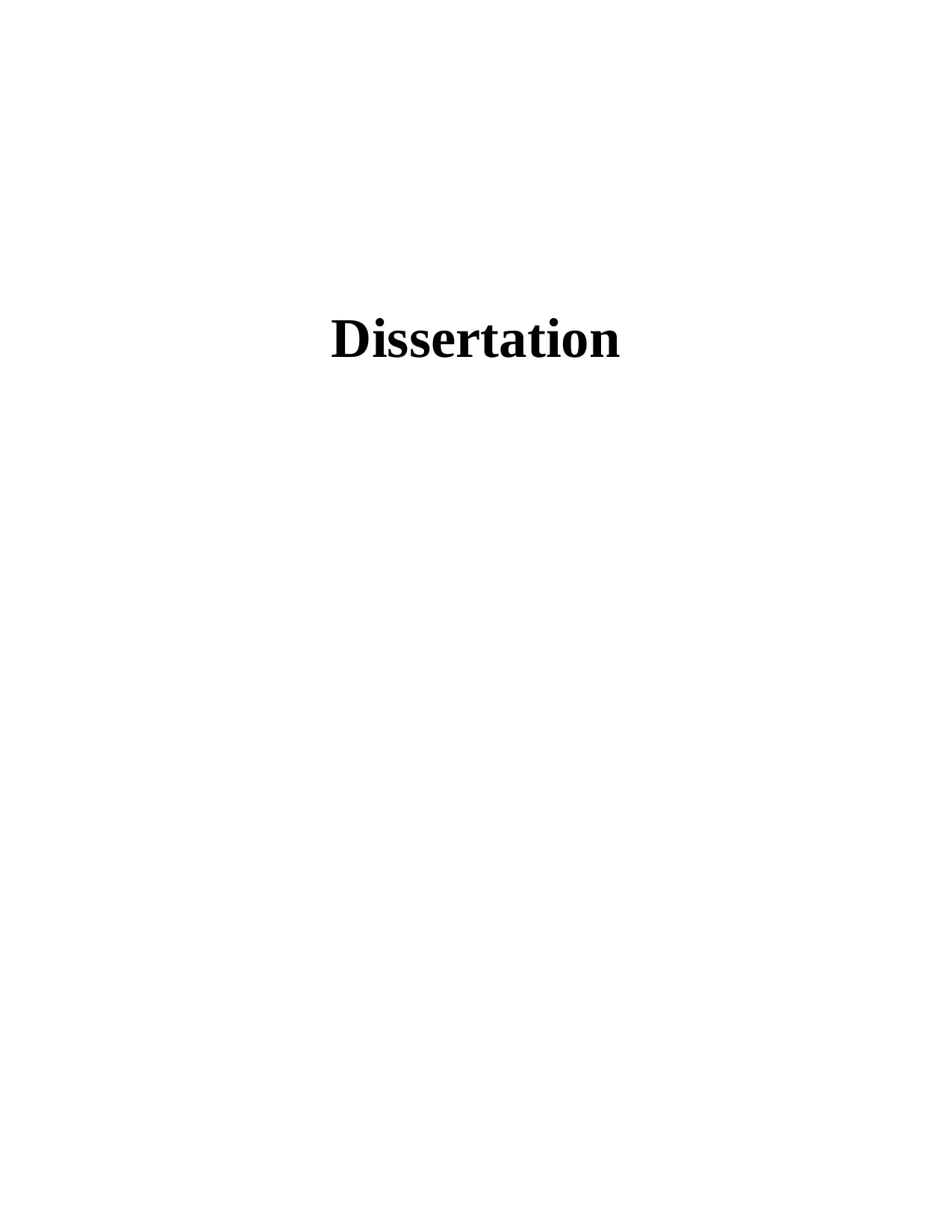
Dissertation
Paraphrase This Document
Need a fresh take? Get an instant paraphrase of this document with our AI Paraphraser
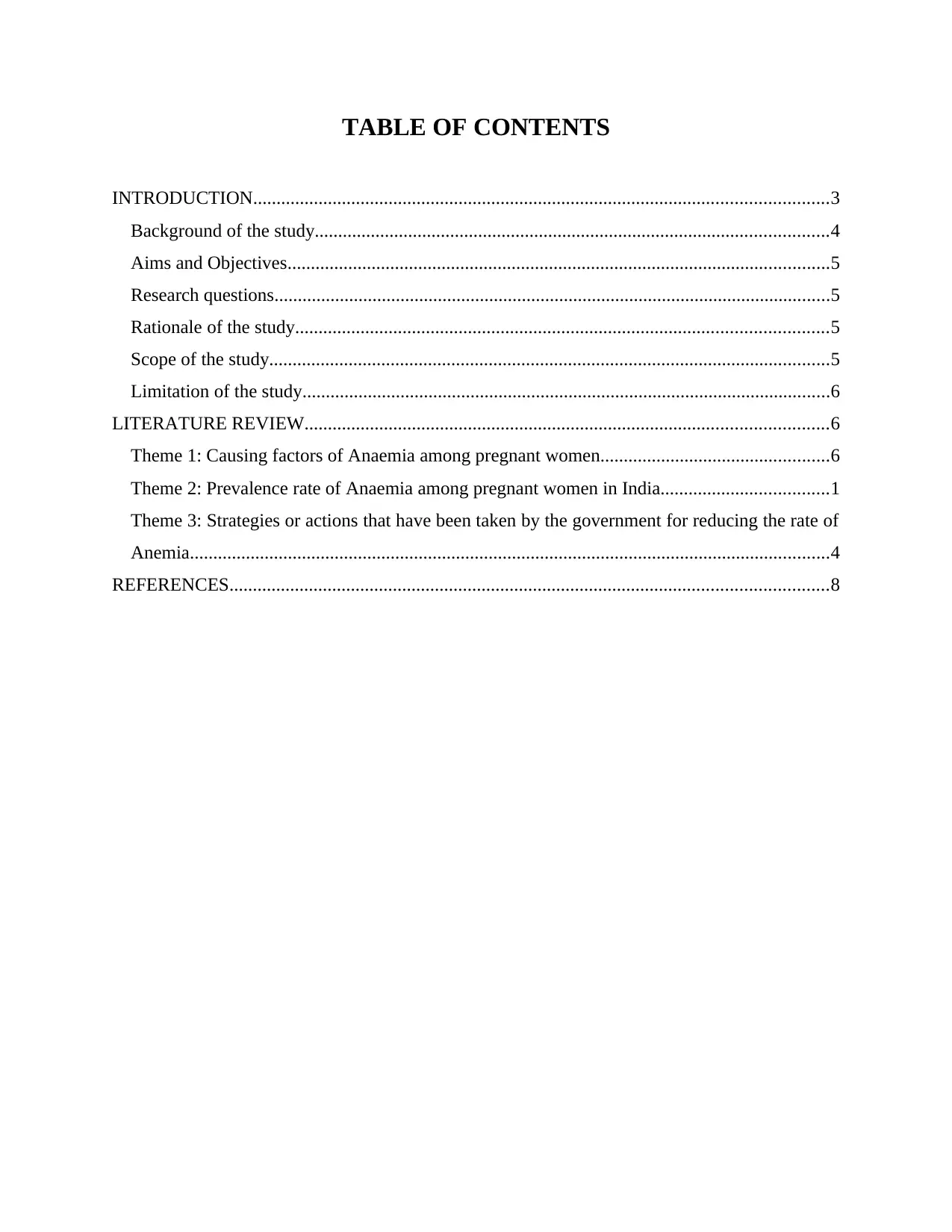
TABLE OF CONTENTS
INTRODUCTION...........................................................................................................................3
Background of the study..............................................................................................................4
Aims and Objectives....................................................................................................................5
Research questions.......................................................................................................................5
Rationale of the study..................................................................................................................5
Scope of the study........................................................................................................................5
Limitation of the study.................................................................................................................6
LITERATURE REVIEW................................................................................................................6
Theme 1: Causing factors of Anaemia among pregnant women.................................................6
Theme 2: Prevalence rate of Anaemia among pregnant women in India....................................1
Theme 3: Strategies or actions that have been taken by the government for reducing the rate of
Anemia.........................................................................................................................................4
REFERENCES................................................................................................................................8
INTRODUCTION...........................................................................................................................3
Background of the study..............................................................................................................4
Aims and Objectives....................................................................................................................5
Research questions.......................................................................................................................5
Rationale of the study..................................................................................................................5
Scope of the study........................................................................................................................5
Limitation of the study.................................................................................................................6
LITERATURE REVIEW................................................................................................................6
Theme 1: Causing factors of Anaemia among pregnant women.................................................6
Theme 2: Prevalence rate of Anaemia among pregnant women in India....................................1
Theme 3: Strategies or actions that have been taken by the government for reducing the rate of
Anemia.........................................................................................................................................4
REFERENCES................................................................................................................................8
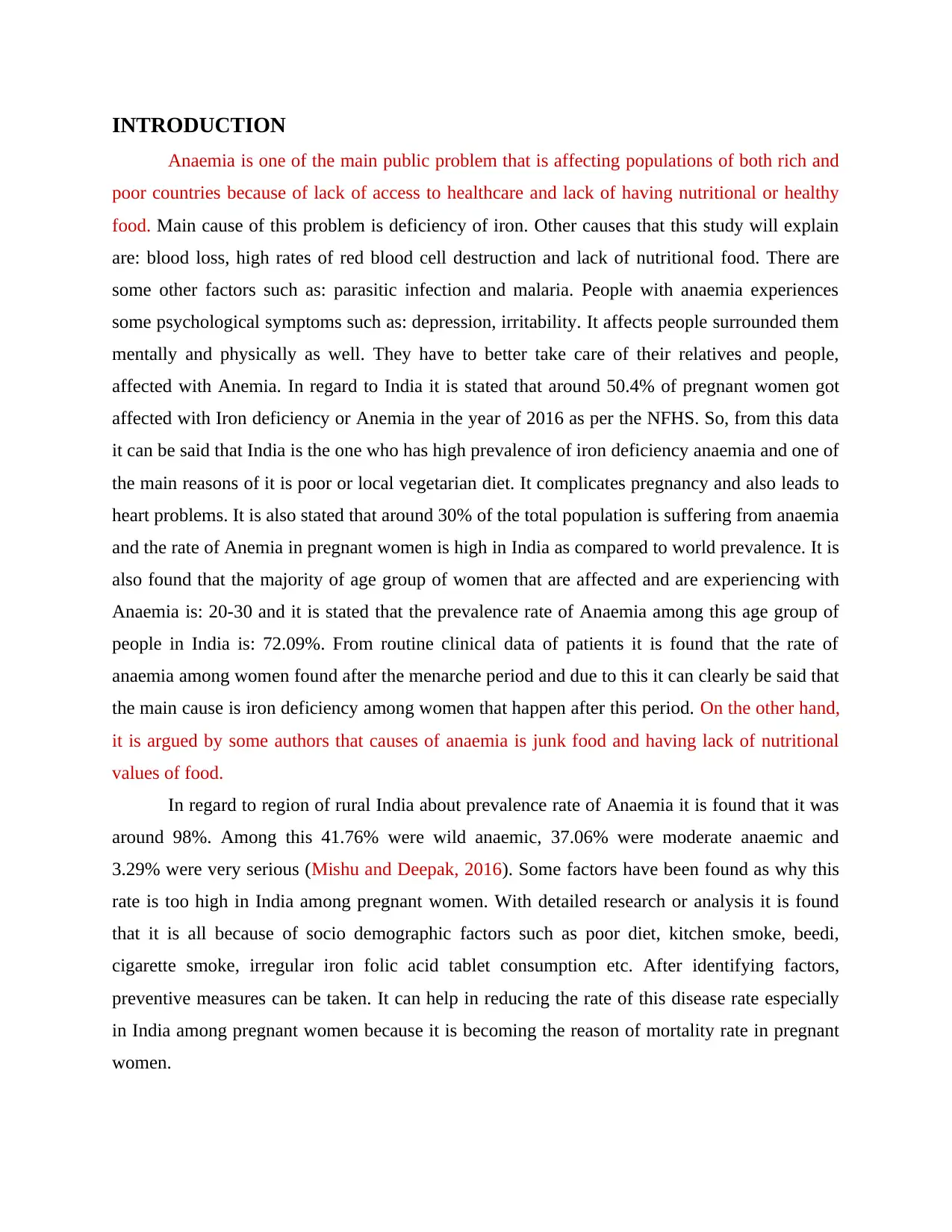
INTRODUCTION
Anaemia is one of the main public problem that is affecting populations of both rich and
poor countries because of lack of access to healthcare and lack of having nutritional or healthy
food. Main cause of this problem is deficiency of iron. Other causes that this study will explain
are: blood loss, high rates of red blood cell destruction and lack of nutritional food. There are
some other factors such as: parasitic infection and malaria. People with anaemia experiences
some psychological symptoms such as: depression, irritability. It affects people surrounded them
mentally and physically as well. They have to better take care of their relatives and people,
affected with Anemia. In regard to India it is stated that around 50.4% of pregnant women got
affected with Iron deficiency or Anemia in the year of 2016 as per the NFHS. So, from this data
it can be said that India is the one who has high prevalence of iron deficiency anaemia and one of
the main reasons of it is poor or local vegetarian diet. It complicates pregnancy and also leads to
heart problems. It is also stated that around 30% of the total population is suffering from anaemia
and the rate of Anemia in pregnant women is high in India as compared to world prevalence. It is
also found that the majority of age group of women that are affected and are experiencing with
Anaemia is: 20-30 and it is stated that the prevalence rate of Anaemia among this age group of
people in India is: 72.09%. From routine clinical data of patients it is found that the rate of
anaemia among women found after the menarche period and due to this it can clearly be said that
the main cause is iron deficiency among women that happen after this period. On the other hand,
it is argued by some authors that causes of anaemia is junk food and having lack of nutritional
values of food.
In regard to region of rural India about prevalence rate of Anaemia it is found that it was
around 98%. Among this 41.76% were wild anaemic, 37.06% were moderate anaemic and
3.29% were very serious (Mishu and Deepak, 2016). Some factors have been found as why this
rate is too high in India among pregnant women. With detailed research or analysis it is found
that it is all because of socio demographic factors such as poor diet, kitchen smoke, beedi,
cigarette smoke, irregular iron folic acid tablet consumption etc. After identifying factors,
preventive measures can be taken. It can help in reducing the rate of this disease rate especially
in India among pregnant women because it is becoming the reason of mortality rate in pregnant
women.
Anaemia is one of the main public problem that is affecting populations of both rich and
poor countries because of lack of access to healthcare and lack of having nutritional or healthy
food. Main cause of this problem is deficiency of iron. Other causes that this study will explain
are: blood loss, high rates of red blood cell destruction and lack of nutritional food. There are
some other factors such as: parasitic infection and malaria. People with anaemia experiences
some psychological symptoms such as: depression, irritability. It affects people surrounded them
mentally and physically as well. They have to better take care of their relatives and people,
affected with Anemia. In regard to India it is stated that around 50.4% of pregnant women got
affected with Iron deficiency or Anemia in the year of 2016 as per the NFHS. So, from this data
it can be said that India is the one who has high prevalence of iron deficiency anaemia and one of
the main reasons of it is poor or local vegetarian diet. It complicates pregnancy and also leads to
heart problems. It is also stated that around 30% of the total population is suffering from anaemia
and the rate of Anemia in pregnant women is high in India as compared to world prevalence. It is
also found that the majority of age group of women that are affected and are experiencing with
Anaemia is: 20-30 and it is stated that the prevalence rate of Anaemia among this age group of
people in India is: 72.09%. From routine clinical data of patients it is found that the rate of
anaemia among women found after the menarche period and due to this it can clearly be said that
the main cause is iron deficiency among women that happen after this period. On the other hand,
it is argued by some authors that causes of anaemia is junk food and having lack of nutritional
values of food.
In regard to region of rural India about prevalence rate of Anaemia it is found that it was
around 98%. Among this 41.76% were wild anaemic, 37.06% were moderate anaemic and
3.29% were very serious (Mishu and Deepak, 2016). Some factors have been found as why this
rate is too high in India among pregnant women. With detailed research or analysis it is found
that it is all because of socio demographic factors such as poor diet, kitchen smoke, beedi,
cigarette smoke, irregular iron folic acid tablet consumption etc. After identifying factors,
preventive measures can be taken. It can help in reducing the rate of this disease rate especially
in India among pregnant women because it is becoming the reason of mortality rate in pregnant
women.
⊘ This is a preview!⊘
Do you want full access?
Subscribe today to unlock all pages.

Trusted by 1+ million students worldwide
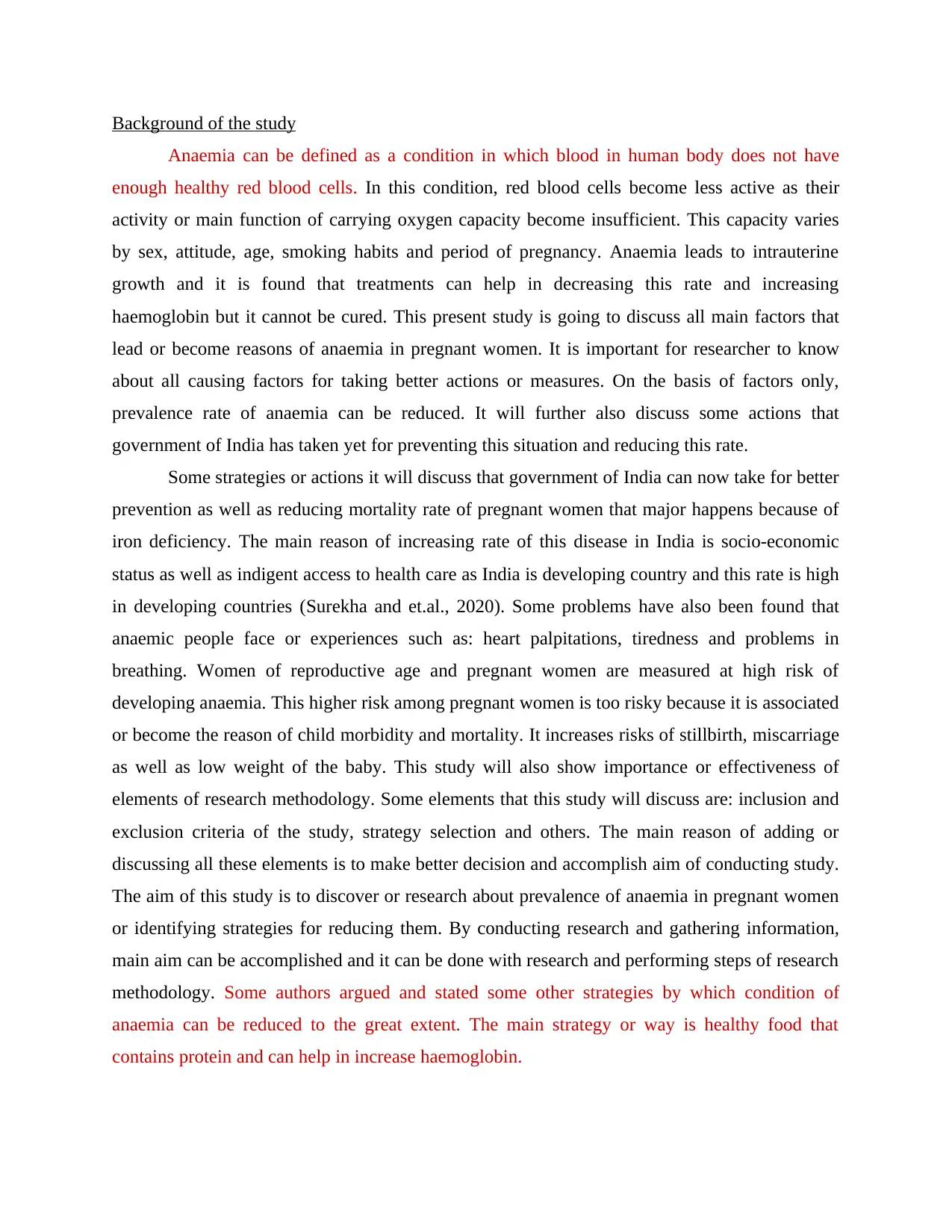
Background of the study
Anaemia can be defined as a condition in which blood in human body does not have
enough healthy red blood cells. In this condition, red blood cells become less active as their
activity or main function of carrying oxygen capacity become insufficient. This capacity varies
by sex, attitude, age, smoking habits and period of pregnancy. Anaemia leads to intrauterine
growth and it is found that treatments can help in decreasing this rate and increasing
haemoglobin but it cannot be cured. This present study is going to discuss all main factors that
lead or become reasons of anaemia in pregnant women. It is important for researcher to know
about all causing factors for taking better actions or measures. On the basis of factors only,
prevalence rate of anaemia can be reduced. It will further also discuss some actions that
government of India has taken yet for preventing this situation and reducing this rate.
Some strategies or actions it will discuss that government of India can now take for better
prevention as well as reducing mortality rate of pregnant women that major happens because of
iron deficiency. The main reason of increasing rate of this disease in India is socio-economic
status as well as indigent access to health care as India is developing country and this rate is high
in developing countries (Surekha and et.al., 2020). Some problems have also been found that
anaemic people face or experiences such as: heart palpitations, tiredness and problems in
breathing. Women of reproductive age and pregnant women are measured at high risk of
developing anaemia. This higher risk among pregnant women is too risky because it is associated
or become the reason of child morbidity and mortality. It increases risks of stillbirth, miscarriage
as well as low weight of the baby. This study will also show importance or effectiveness of
elements of research methodology. Some elements that this study will discuss are: inclusion and
exclusion criteria of the study, strategy selection and others. The main reason of adding or
discussing all these elements is to make better decision and accomplish aim of conducting study.
The aim of this study is to discover or research about prevalence of anaemia in pregnant women
or identifying strategies for reducing them. By conducting research and gathering information,
main aim can be accomplished and it can be done with research and performing steps of research
methodology. Some authors argued and stated some other strategies by which condition of
anaemia can be reduced to the great extent. The main strategy or way is healthy food that
contains protein and can help in increase haemoglobin.
Anaemia can be defined as a condition in which blood in human body does not have
enough healthy red blood cells. In this condition, red blood cells become less active as their
activity or main function of carrying oxygen capacity become insufficient. This capacity varies
by sex, attitude, age, smoking habits and period of pregnancy. Anaemia leads to intrauterine
growth and it is found that treatments can help in decreasing this rate and increasing
haemoglobin but it cannot be cured. This present study is going to discuss all main factors that
lead or become reasons of anaemia in pregnant women. It is important for researcher to know
about all causing factors for taking better actions or measures. On the basis of factors only,
prevalence rate of anaemia can be reduced. It will further also discuss some actions that
government of India has taken yet for preventing this situation and reducing this rate.
Some strategies or actions it will discuss that government of India can now take for better
prevention as well as reducing mortality rate of pregnant women that major happens because of
iron deficiency. The main reason of increasing rate of this disease in India is socio-economic
status as well as indigent access to health care as India is developing country and this rate is high
in developing countries (Surekha and et.al., 2020). Some problems have also been found that
anaemic people face or experiences such as: heart palpitations, tiredness and problems in
breathing. Women of reproductive age and pregnant women are measured at high risk of
developing anaemia. This higher risk among pregnant women is too risky because it is associated
or become the reason of child morbidity and mortality. It increases risks of stillbirth, miscarriage
as well as low weight of the baby. This study will also show importance or effectiveness of
elements of research methodology. Some elements that this study will discuss are: inclusion and
exclusion criteria of the study, strategy selection and others. The main reason of adding or
discussing all these elements is to make better decision and accomplish aim of conducting study.
The aim of this study is to discover or research about prevalence of anaemia in pregnant women
or identifying strategies for reducing them. By conducting research and gathering information,
main aim can be accomplished and it can be done with research and performing steps of research
methodology. Some authors argued and stated some other strategies by which condition of
anaemia can be reduced to the great extent. The main strategy or way is healthy food that
contains protein and can help in increase haemoglobin.
Paraphrase This Document
Need a fresh take? Get an instant paraphrase of this document with our AI Paraphraser
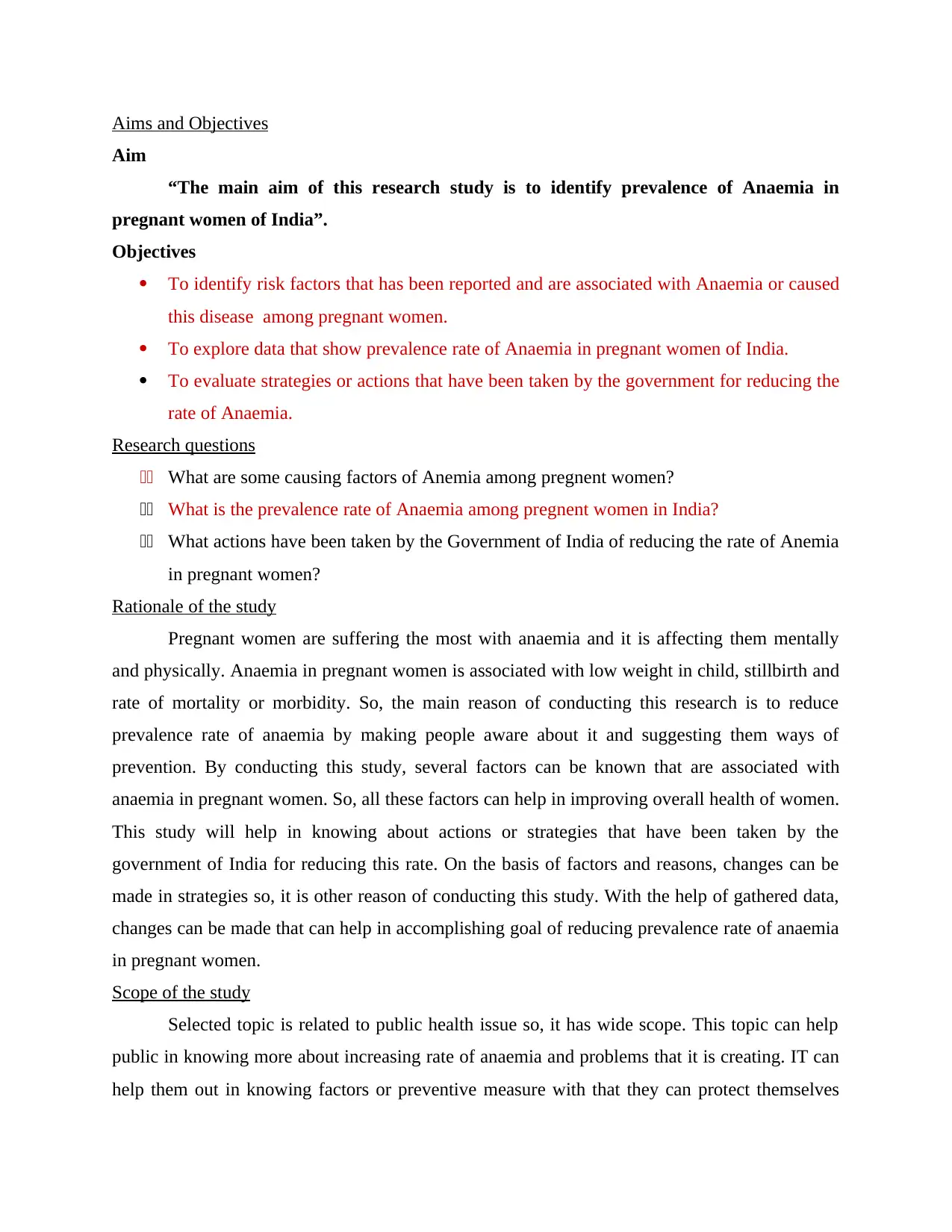
Aims and Objectives
Aim
“The main aim of this research study is to identify prevalence of Anaemia in
pregnant women of India”.
Objectives
To identify risk factors that has been reported and are associated with Anaemia or caused
this disease among pregnant women.
To explore data that show prevalence rate of Anaemia in pregnant women of India.
To evaluate strategies or actions that have been taken by the government for reducing the
rate of Anaemia.
Research questions
11 What are some causing factors of Anemia among pregnent women?
11 What is the prevalence rate of Anaemia among pregnent women in India?
11 What actions have been taken by the Government of India of reducing the rate of Anemia
in pregnant women?
Rationale of the study
Pregnant women are suffering the most with anaemia and it is affecting them mentally
and physically. Anaemia in pregnant women is associated with low weight in child, stillbirth and
rate of mortality or morbidity. So, the main reason of conducting this research is to reduce
prevalence rate of anaemia by making people aware about it and suggesting them ways of
prevention. By conducting this study, several factors can be known that are associated with
anaemia in pregnant women. So, all these factors can help in improving overall health of women.
This study will help in knowing about actions or strategies that have been taken by the
government of India for reducing this rate. On the basis of factors and reasons, changes can be
made in strategies so, it is other reason of conducting this study. With the help of gathered data,
changes can be made that can help in accomplishing goal of reducing prevalence rate of anaemia
in pregnant women.
Scope of the study
Selected topic is related to public health issue so, it has wide scope. This topic can help
public in knowing more about increasing rate of anaemia and problems that it is creating. IT can
help them out in knowing factors or preventive measure with that they can protect themselves
Aim
“The main aim of this research study is to identify prevalence of Anaemia in
pregnant women of India”.
Objectives
To identify risk factors that has been reported and are associated with Anaemia or caused
this disease among pregnant women.
To explore data that show prevalence rate of Anaemia in pregnant women of India.
To evaluate strategies or actions that have been taken by the government for reducing the
rate of Anaemia.
Research questions
11 What are some causing factors of Anemia among pregnent women?
11 What is the prevalence rate of Anaemia among pregnent women in India?
11 What actions have been taken by the Government of India of reducing the rate of Anemia
in pregnant women?
Rationale of the study
Pregnant women are suffering the most with anaemia and it is affecting them mentally
and physically. Anaemia in pregnant women is associated with low weight in child, stillbirth and
rate of mortality or morbidity. So, the main reason of conducting this research is to reduce
prevalence rate of anaemia by making people aware about it and suggesting them ways of
prevention. By conducting this study, several factors can be known that are associated with
anaemia in pregnant women. So, all these factors can help in improving overall health of women.
This study will help in knowing about actions or strategies that have been taken by the
government of India for reducing this rate. On the basis of factors and reasons, changes can be
made in strategies so, it is other reason of conducting this study. With the help of gathered data,
changes can be made that can help in accomplishing goal of reducing prevalence rate of anaemia
in pregnant women.
Scope of the study
Selected topic is related to public health issue so, it has wide scope. This topic can help
public in knowing more about increasing rate of anaemia and problems that it is creating. IT can
help them out in knowing factors or preventive measure with that they can protect themselves
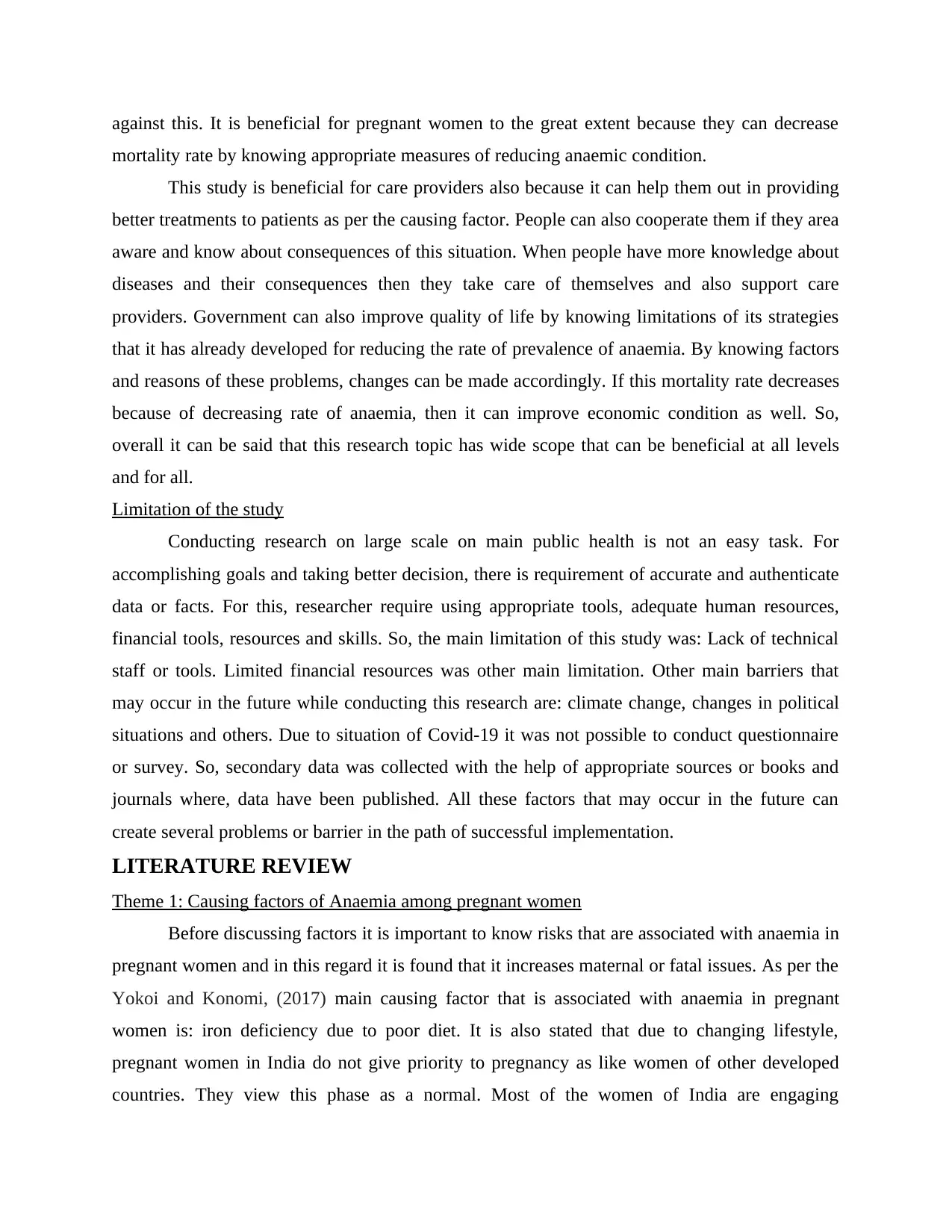
against this. It is beneficial for pregnant women to the great extent because they can decrease
mortality rate by knowing appropriate measures of reducing anaemic condition.
This study is beneficial for care providers also because it can help them out in providing
better treatments to patients as per the causing factor. People can also cooperate them if they area
aware and know about consequences of this situation. When people have more knowledge about
diseases and their consequences then they take care of themselves and also support care
providers. Government can also improve quality of life by knowing limitations of its strategies
that it has already developed for reducing the rate of prevalence of anaemia. By knowing factors
and reasons of these problems, changes can be made accordingly. If this mortality rate decreases
because of decreasing rate of anaemia, then it can improve economic condition as well. So,
overall it can be said that this research topic has wide scope that can be beneficial at all levels
and for all.
Limitation of the study
Conducting research on large scale on main public health is not an easy task. For
accomplishing goals and taking better decision, there is requirement of accurate and authenticate
data or facts. For this, researcher require using appropriate tools, adequate human resources,
financial tools, resources and skills. So, the main limitation of this study was: Lack of technical
staff or tools. Limited financial resources was other main limitation. Other main barriers that
may occur in the future while conducting this research are: climate change, changes in political
situations and others. Due to situation of Covid-19 it was not possible to conduct questionnaire
or survey. So, secondary data was collected with the help of appropriate sources or books and
journals where, data have been published. All these factors that may occur in the future can
create several problems or barrier in the path of successful implementation.
LITERATURE REVIEW
Theme 1: Causing factors of Anaemia among pregnant women
Before discussing factors it is important to know risks that are associated with anaemia in
pregnant women and in this regard it is found that it increases maternal or fatal issues. As per the
Yokoi and Konomi, (2017) main causing factor that is associated with anaemia in pregnant
women is: iron deficiency due to poor diet. It is also stated that due to changing lifestyle,
pregnant women in India do not give priority to pregnancy as like women of other developed
countries. They view this phase as a normal. Most of the women of India are engaging
mortality rate by knowing appropriate measures of reducing anaemic condition.
This study is beneficial for care providers also because it can help them out in providing
better treatments to patients as per the causing factor. People can also cooperate them if they area
aware and know about consequences of this situation. When people have more knowledge about
diseases and their consequences then they take care of themselves and also support care
providers. Government can also improve quality of life by knowing limitations of its strategies
that it has already developed for reducing the rate of prevalence of anaemia. By knowing factors
and reasons of these problems, changes can be made accordingly. If this mortality rate decreases
because of decreasing rate of anaemia, then it can improve economic condition as well. So,
overall it can be said that this research topic has wide scope that can be beneficial at all levels
and for all.
Limitation of the study
Conducting research on large scale on main public health is not an easy task. For
accomplishing goals and taking better decision, there is requirement of accurate and authenticate
data or facts. For this, researcher require using appropriate tools, adequate human resources,
financial tools, resources and skills. So, the main limitation of this study was: Lack of technical
staff or tools. Limited financial resources was other main limitation. Other main barriers that
may occur in the future while conducting this research are: climate change, changes in political
situations and others. Due to situation of Covid-19 it was not possible to conduct questionnaire
or survey. So, secondary data was collected with the help of appropriate sources or books and
journals where, data have been published. All these factors that may occur in the future can
create several problems or barrier in the path of successful implementation.
LITERATURE REVIEW
Theme 1: Causing factors of Anaemia among pregnant women
Before discussing factors it is important to know risks that are associated with anaemia in
pregnant women and in this regard it is found that it increases maternal or fatal issues. As per the
Yokoi and Konomi, (2017) main causing factor that is associated with anaemia in pregnant
women is: iron deficiency due to poor diet. It is also stated that due to changing lifestyle,
pregnant women in India do not give priority to pregnancy as like women of other developed
countries. They view this phase as a normal. Most of the women of India are engaging
⊘ This is a preview!⊘
Do you want full access?
Subscribe today to unlock all pages.

Trusted by 1+ million students worldwide
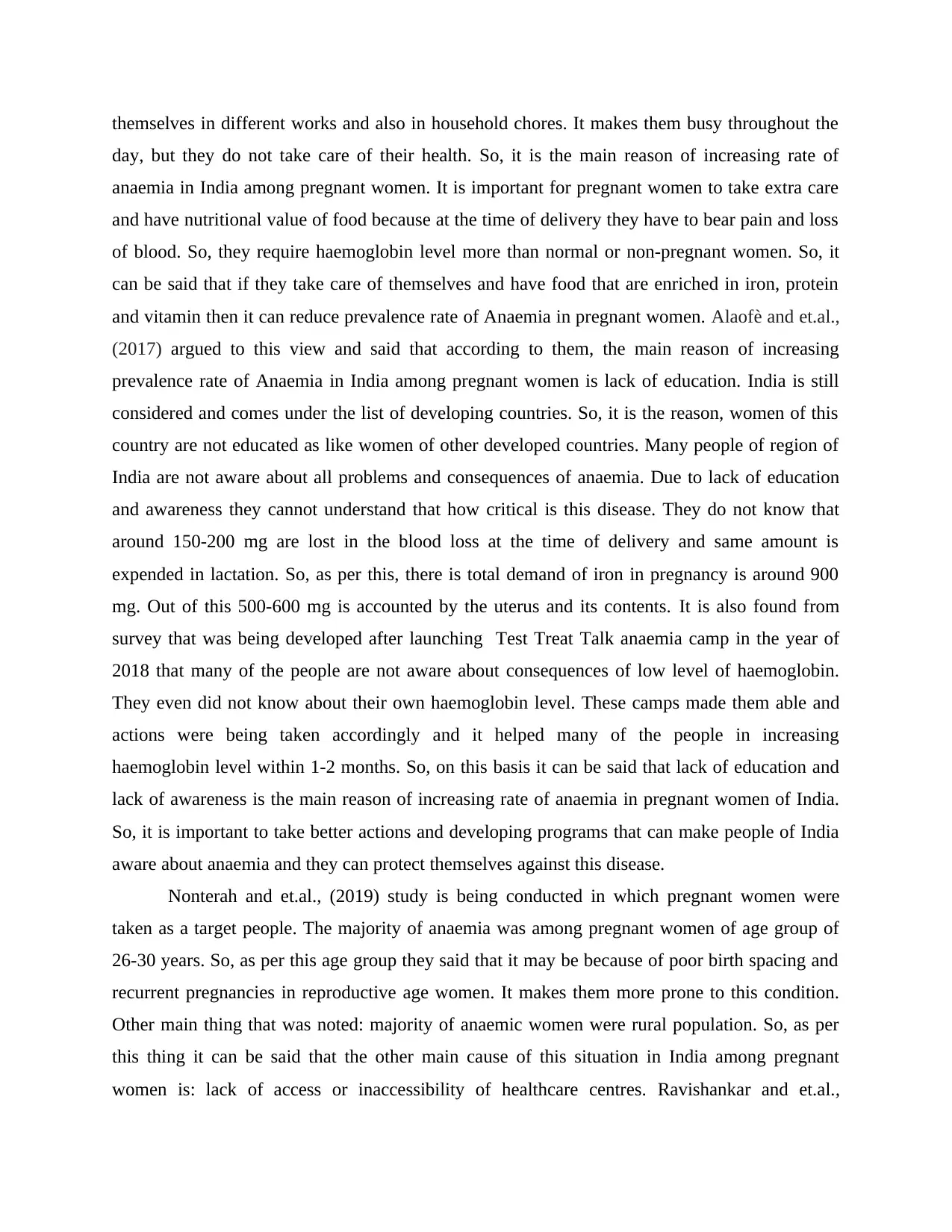
themselves in different works and also in household chores. It makes them busy throughout the
day, but they do not take care of their health. So, it is the main reason of increasing rate of
anaemia in India among pregnant women. It is important for pregnant women to take extra care
and have nutritional value of food because at the time of delivery they have to bear pain and loss
of blood. So, they require haemoglobin level more than normal or non-pregnant women. So, it
can be said that if they take care of themselves and have food that are enriched in iron, protein
and vitamin then it can reduce prevalence rate of Anaemia in pregnant women. Alaofè and et.al.,
(2017) argued to this view and said that according to them, the main reason of increasing
prevalence rate of Anaemia in India among pregnant women is lack of education. India is still
considered and comes under the list of developing countries. So, it is the reason, women of this
country are not educated as like women of other developed countries. Many people of region of
India are not aware about all problems and consequences of anaemia. Due to lack of education
and awareness they cannot understand that how critical is this disease. They do not know that
around 150-200 mg are lost in the blood loss at the time of delivery and same amount is
expended in lactation. So, as per this, there is total demand of iron in pregnancy is around 900
mg. Out of this 500-600 mg is accounted by the uterus and its contents. It is also found from
survey that was being developed after launching Test Treat Talk anaemia camp in the year of
2018 that many of the people are not aware about consequences of low level of haemoglobin.
They even did not know about their own haemoglobin level. These camps made them able and
actions were being taken accordingly and it helped many of the people in increasing
haemoglobin level within 1-2 months. So, on this basis it can be said that lack of education and
lack of awareness is the main reason of increasing rate of anaemia in pregnant women of India.
So, it is important to take better actions and developing programs that can make people of India
aware about anaemia and they can protect themselves against this disease.
Nonterah and et.al., (2019) study is being conducted in which pregnant women were
taken as a target people. The majority of anaemia was among pregnant women of age group of
26-30 years. So, as per this age group they said that it may be because of poor birth spacing and
recurrent pregnancies in reproductive age women. It makes them more prone to this condition.
Other main thing that was noted: majority of anaemic women were rural population. So, as per
this thing it can be said that the other main cause of this situation in India among pregnant
women is: lack of access or inaccessibility of healthcare centres. Ravishankar and et.al.,
day, but they do not take care of their health. So, it is the main reason of increasing rate of
anaemia in India among pregnant women. It is important for pregnant women to take extra care
and have nutritional value of food because at the time of delivery they have to bear pain and loss
of blood. So, they require haemoglobin level more than normal or non-pregnant women. So, it
can be said that if they take care of themselves and have food that are enriched in iron, protein
and vitamin then it can reduce prevalence rate of Anaemia in pregnant women. Alaofè and et.al.,
(2017) argued to this view and said that according to them, the main reason of increasing
prevalence rate of Anaemia in India among pregnant women is lack of education. India is still
considered and comes under the list of developing countries. So, it is the reason, women of this
country are not educated as like women of other developed countries. Many people of region of
India are not aware about all problems and consequences of anaemia. Due to lack of education
and awareness they cannot understand that how critical is this disease. They do not know that
around 150-200 mg are lost in the blood loss at the time of delivery and same amount is
expended in lactation. So, as per this, there is total demand of iron in pregnancy is around 900
mg. Out of this 500-600 mg is accounted by the uterus and its contents. It is also found from
survey that was being developed after launching Test Treat Talk anaemia camp in the year of
2018 that many of the people are not aware about consequences of low level of haemoglobin.
They even did not know about their own haemoglobin level. These camps made them able and
actions were being taken accordingly and it helped many of the people in increasing
haemoglobin level within 1-2 months. So, on this basis it can be said that lack of education and
lack of awareness is the main reason of increasing rate of anaemia in pregnant women of India.
So, it is important to take better actions and developing programs that can make people of India
aware about anaemia and they can protect themselves against this disease.
Nonterah and et.al., (2019) study is being conducted in which pregnant women were
taken as a target people. The majority of anaemia was among pregnant women of age group of
26-30 years. So, as per this age group they said that it may be because of poor birth spacing and
recurrent pregnancies in reproductive age women. It makes them more prone to this condition.
Other main thing that was noted: majority of anaemic women were rural population. So, as per
this thing it can be said that the other main cause of this situation in India among pregnant
women is: lack of access or inaccessibility of healthcare centres. Ravishankar and et.al.,
Paraphrase This Document
Need a fresh take? Get an instant paraphrase of this document with our AI Paraphraser
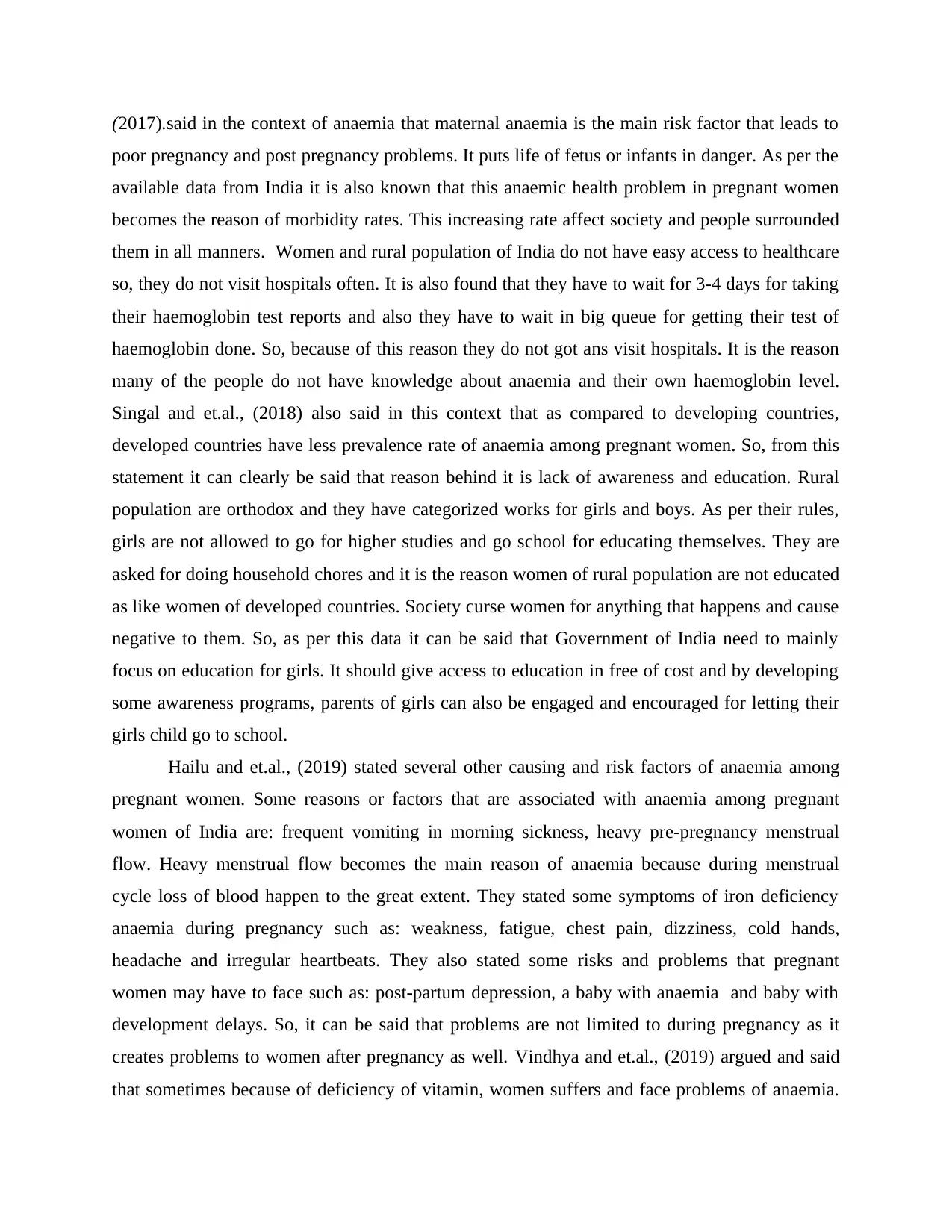
(2017).said in the context of anaemia that maternal anaemia is the main risk factor that leads to
poor pregnancy and post pregnancy problems. It puts life of fetus or infants in danger. As per the
available data from India it is also known that this anaemic health problem in pregnant women
becomes the reason of morbidity rates. This increasing rate affect society and people surrounded
them in all manners. Women and rural population of India do not have easy access to healthcare
so, they do not visit hospitals often. It is also found that they have to wait for 3-4 days for taking
their haemoglobin test reports and also they have to wait in big queue for getting their test of
haemoglobin done. So, because of this reason they do not got ans visit hospitals. It is the reason
many of the people do not have knowledge about anaemia and their own haemoglobin level.
Singal and et.al., (2018) also said in this context that as compared to developing countries,
developed countries have less prevalence rate of anaemia among pregnant women. So, from this
statement it can clearly be said that reason behind it is lack of awareness and education. Rural
population are orthodox and they have categorized works for girls and boys. As per their rules,
girls are not allowed to go for higher studies and go school for educating themselves. They are
asked for doing household chores and it is the reason women of rural population are not educated
as like women of developed countries. Society curse women for anything that happens and cause
negative to them. So, as per this data it can be said that Government of India need to mainly
focus on education for girls. It should give access to education in free of cost and by developing
some awareness programs, parents of girls can also be engaged and encouraged for letting their
girls child go to school.
Hailu and et.al., (2019) stated several other causing and risk factors of anaemia among
pregnant women. Some reasons or factors that are associated with anaemia among pregnant
women of India are: frequent vomiting in morning sickness, heavy pre-pregnancy menstrual
flow. Heavy menstrual flow becomes the main reason of anaemia because during menstrual
cycle loss of blood happen to the great extent. They stated some symptoms of iron deficiency
anaemia during pregnancy such as: weakness, fatigue, chest pain, dizziness, cold hands,
headache and irregular heartbeats. They also stated some risks and problems that pregnant
women may have to face such as: post-partum depression, a baby with anaemia and baby with
development delays. So, it can be said that problems are not limited to during pregnancy as it
creates problems to women after pregnancy as well. Vindhya and et.al., (2019) argued and said
that sometimes because of deficiency of vitamin, women suffers and face problems of anaemia.
poor pregnancy and post pregnancy problems. It puts life of fetus or infants in danger. As per the
available data from India it is also known that this anaemic health problem in pregnant women
becomes the reason of morbidity rates. This increasing rate affect society and people surrounded
them in all manners. Women and rural population of India do not have easy access to healthcare
so, they do not visit hospitals often. It is also found that they have to wait for 3-4 days for taking
their haemoglobin test reports and also they have to wait in big queue for getting their test of
haemoglobin done. So, because of this reason they do not got ans visit hospitals. It is the reason
many of the people do not have knowledge about anaemia and their own haemoglobin level.
Singal and et.al., (2018) also said in this context that as compared to developing countries,
developed countries have less prevalence rate of anaemia among pregnant women. So, from this
statement it can clearly be said that reason behind it is lack of awareness and education. Rural
population are orthodox and they have categorized works for girls and boys. As per their rules,
girls are not allowed to go for higher studies and go school for educating themselves. They are
asked for doing household chores and it is the reason women of rural population are not educated
as like women of developed countries. Society curse women for anything that happens and cause
negative to them. So, as per this data it can be said that Government of India need to mainly
focus on education for girls. It should give access to education in free of cost and by developing
some awareness programs, parents of girls can also be engaged and encouraged for letting their
girls child go to school.
Hailu and et.al., (2019) stated several other causing and risk factors of anaemia among
pregnant women. Some reasons or factors that are associated with anaemia among pregnant
women of India are: frequent vomiting in morning sickness, heavy pre-pregnancy menstrual
flow. Heavy menstrual flow becomes the main reason of anaemia because during menstrual
cycle loss of blood happen to the great extent. They stated some symptoms of iron deficiency
anaemia during pregnancy such as: weakness, fatigue, chest pain, dizziness, cold hands,
headache and irregular heartbeats. They also stated some risks and problems that pregnant
women may have to face such as: post-partum depression, a baby with anaemia and baby with
development delays. So, it can be said that problems are not limited to during pregnancy as it
creates problems to women after pregnancy as well. Vindhya and et.al., (2019) argued and said
that sometimes because of deficiency of vitamin, women suffers and face problems of anaemia.
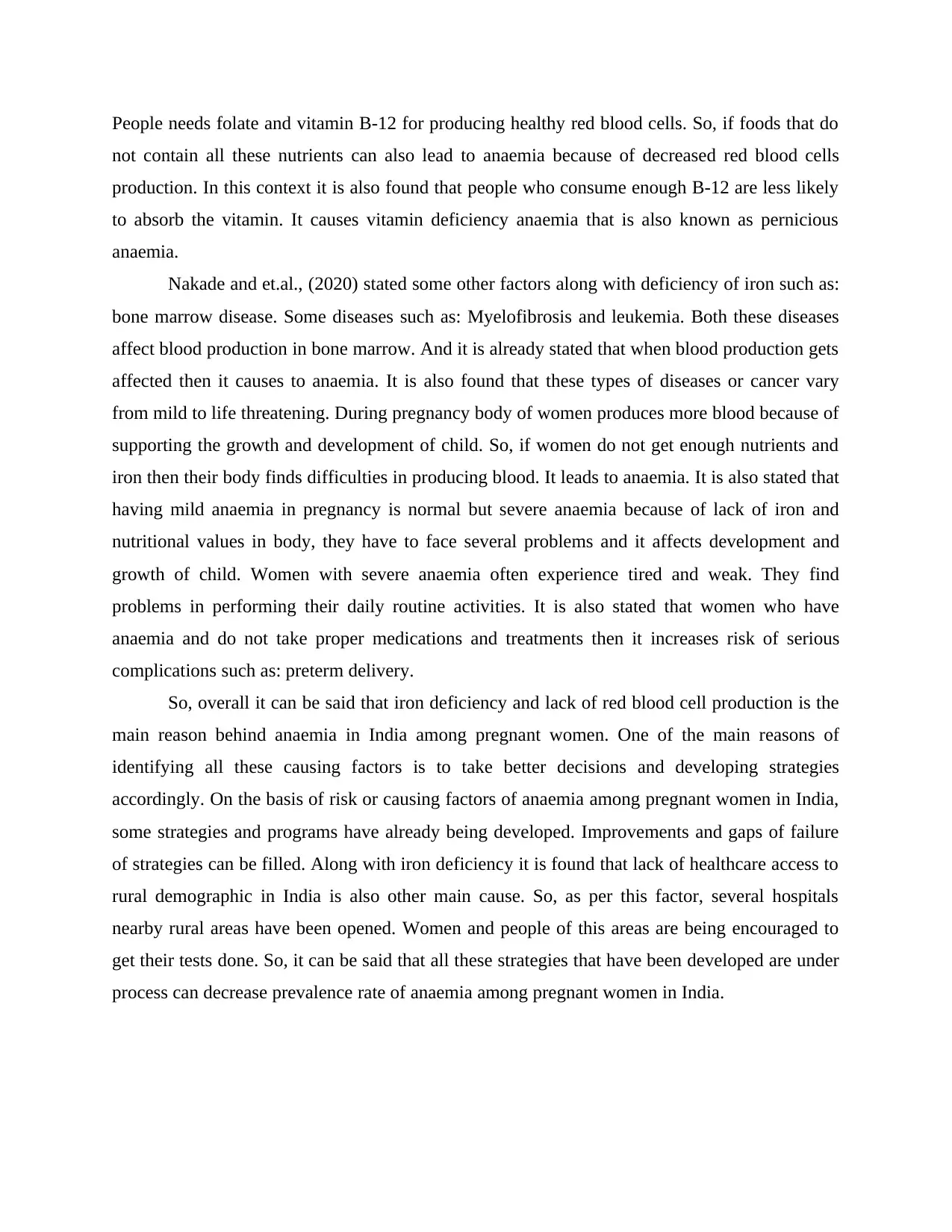
People needs folate and vitamin B-12 for producing healthy red blood cells. So, if foods that do
not contain all these nutrients can also lead to anaemia because of decreased red blood cells
production. In this context it is also found that people who consume enough B-12 are less likely
to absorb the vitamin. It causes vitamin deficiency anaemia that is also known as pernicious
anaemia.
Nakade and et.al., (2020) stated some other factors along with deficiency of iron such as:
bone marrow disease. Some diseases such as: Myelofibrosis and leukemia. Both these diseases
affect blood production in bone marrow. And it is already stated that when blood production gets
affected then it causes to anaemia. It is also found that these types of diseases or cancer vary
from mild to life threatening. During pregnancy body of women produces more blood because of
supporting the growth and development of child. So, if women do not get enough nutrients and
iron then their body finds difficulties in producing blood. It leads to anaemia. It is also stated that
having mild anaemia in pregnancy is normal but severe anaemia because of lack of iron and
nutritional values in body, they have to face several problems and it affects development and
growth of child. Women with severe anaemia often experience tired and weak. They find
problems in performing their daily routine activities. It is also stated that women who have
anaemia and do not take proper medications and treatments then it increases risk of serious
complications such as: preterm delivery.
So, overall it can be said that iron deficiency and lack of red blood cell production is the
main reason behind anaemia in India among pregnant women. One of the main reasons of
identifying all these causing factors is to take better decisions and developing strategies
accordingly. On the basis of risk or causing factors of anaemia among pregnant women in India,
some strategies and programs have already being developed. Improvements and gaps of failure
of strategies can be filled. Along with iron deficiency it is found that lack of healthcare access to
rural demographic in India is also other main cause. So, as per this factor, several hospitals
nearby rural areas have been opened. Women and people of this areas are being encouraged to
get their tests done. So, it can be said that all these strategies that have been developed are under
process can decrease prevalence rate of anaemia among pregnant women in India.
not contain all these nutrients can also lead to anaemia because of decreased red blood cells
production. In this context it is also found that people who consume enough B-12 are less likely
to absorb the vitamin. It causes vitamin deficiency anaemia that is also known as pernicious
anaemia.
Nakade and et.al., (2020) stated some other factors along with deficiency of iron such as:
bone marrow disease. Some diseases such as: Myelofibrosis and leukemia. Both these diseases
affect blood production in bone marrow. And it is already stated that when blood production gets
affected then it causes to anaemia. It is also found that these types of diseases or cancer vary
from mild to life threatening. During pregnancy body of women produces more blood because of
supporting the growth and development of child. So, if women do not get enough nutrients and
iron then their body finds difficulties in producing blood. It leads to anaemia. It is also stated that
having mild anaemia in pregnancy is normal but severe anaemia because of lack of iron and
nutritional values in body, they have to face several problems and it affects development and
growth of child. Women with severe anaemia often experience tired and weak. They find
problems in performing their daily routine activities. It is also stated that women who have
anaemia and do not take proper medications and treatments then it increases risk of serious
complications such as: preterm delivery.
So, overall it can be said that iron deficiency and lack of red blood cell production is the
main reason behind anaemia in India among pregnant women. One of the main reasons of
identifying all these causing factors is to take better decisions and developing strategies
accordingly. On the basis of risk or causing factors of anaemia among pregnant women in India,
some strategies and programs have already being developed. Improvements and gaps of failure
of strategies can be filled. Along with iron deficiency it is found that lack of healthcare access to
rural demographic in India is also other main cause. So, as per this factor, several hospitals
nearby rural areas have been opened. Women and people of this areas are being encouraged to
get their tests done. So, it can be said that all these strategies that have been developed are under
process can decrease prevalence rate of anaemia among pregnant women in India.
⊘ This is a preview!⊘
Do you want full access?
Subscribe today to unlock all pages.

Trusted by 1+ million students worldwide
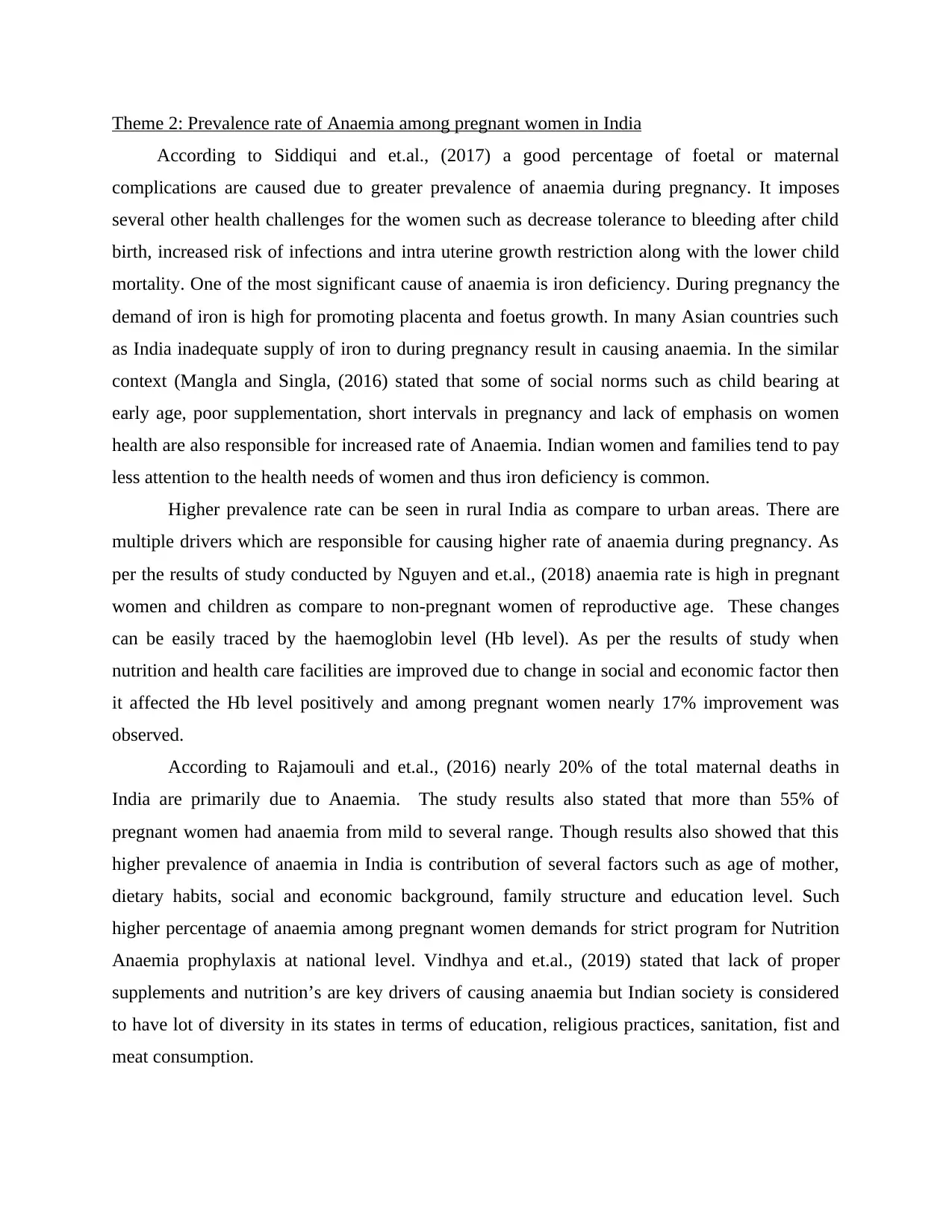
Theme 2: Prevalence rate of Anaemia among pregnant women in India
According to Siddiqui and et.al., (2017) a good percentage of foetal or maternal
complications are caused due to greater prevalence of anaemia during pregnancy. It imposes
several other health challenges for the women such as decrease tolerance to bleeding after child
birth, increased risk of infections and intra uterine growth restriction along with the lower child
mortality. One of the most significant cause of anaemia is iron deficiency. During pregnancy the
demand of iron is high for promoting placenta and foetus growth. In many Asian countries such
as India inadequate supply of iron to during pregnancy result in causing anaemia. In the similar
context (Mangla and Singla, (2016) stated that some of social norms such as child bearing at
early age, poor supplementation, short intervals in pregnancy and lack of emphasis on women
health are also responsible for increased rate of Anaemia. Indian women and families tend to pay
less attention to the health needs of women and thus iron deficiency is common.
Higher prevalence rate can be seen in rural India as compare to urban areas. There are
multiple drivers which are responsible for causing higher rate of anaemia during pregnancy. As
per the results of study conducted by Nguyen and et.al., (2018) anaemia rate is high in pregnant
women and children as compare to non-pregnant women of reproductive age. These changes
can be easily traced by the haemoglobin level (Hb level). As per the results of study when
nutrition and health care facilities are improved due to change in social and economic factor then
it affected the Hb level positively and among pregnant women nearly 17% improvement was
observed.
According to Rajamouli and et.al., (2016) nearly 20% of the total maternal deaths in
India are primarily due to Anaemia. The study results also stated that more than 55% of
pregnant women had anaemia from mild to several range. Though results also showed that this
higher prevalence of anaemia in India is contribution of several factors such as age of mother,
dietary habits, social and economic background, family structure and education level. Such
higher percentage of anaemia among pregnant women demands for strict program for Nutrition
Anaemia prophylaxis at national level. Vindhya and et.al., (2019) stated that lack of proper
supplements and nutrition’s are key drivers of causing anaemia but Indian society is considered
to have lot of diversity in its states in terms of education, religious practices, sanitation, fist and
meat consumption.
According to Siddiqui and et.al., (2017) a good percentage of foetal or maternal
complications are caused due to greater prevalence of anaemia during pregnancy. It imposes
several other health challenges for the women such as decrease tolerance to bleeding after child
birth, increased risk of infections and intra uterine growth restriction along with the lower child
mortality. One of the most significant cause of anaemia is iron deficiency. During pregnancy the
demand of iron is high for promoting placenta and foetus growth. In many Asian countries such
as India inadequate supply of iron to during pregnancy result in causing anaemia. In the similar
context (Mangla and Singla, (2016) stated that some of social norms such as child bearing at
early age, poor supplementation, short intervals in pregnancy and lack of emphasis on women
health are also responsible for increased rate of Anaemia. Indian women and families tend to pay
less attention to the health needs of women and thus iron deficiency is common.
Higher prevalence rate can be seen in rural India as compare to urban areas. There are
multiple drivers which are responsible for causing higher rate of anaemia during pregnancy. As
per the results of study conducted by Nguyen and et.al., (2018) anaemia rate is high in pregnant
women and children as compare to non-pregnant women of reproductive age. These changes
can be easily traced by the haemoglobin level (Hb level). As per the results of study when
nutrition and health care facilities are improved due to change in social and economic factor then
it affected the Hb level positively and among pregnant women nearly 17% improvement was
observed.
According to Rajamouli and et.al., (2016) nearly 20% of the total maternal deaths in
India are primarily due to Anaemia. The study results also stated that more than 55% of
pregnant women had anaemia from mild to several range. Though results also showed that this
higher prevalence of anaemia in India is contribution of several factors such as age of mother,
dietary habits, social and economic background, family structure and education level. Such
higher percentage of anaemia among pregnant women demands for strict program for Nutrition
Anaemia prophylaxis at national level. Vindhya and et.al., (2019) stated that lack of proper
supplements and nutrition’s are key drivers of causing anaemia but Indian society is considered
to have lot of diversity in its states in terms of education, religious practices, sanitation, fist and
meat consumption.
Paraphrase This Document
Need a fresh take? Get an instant paraphrase of this document with our AI Paraphraser
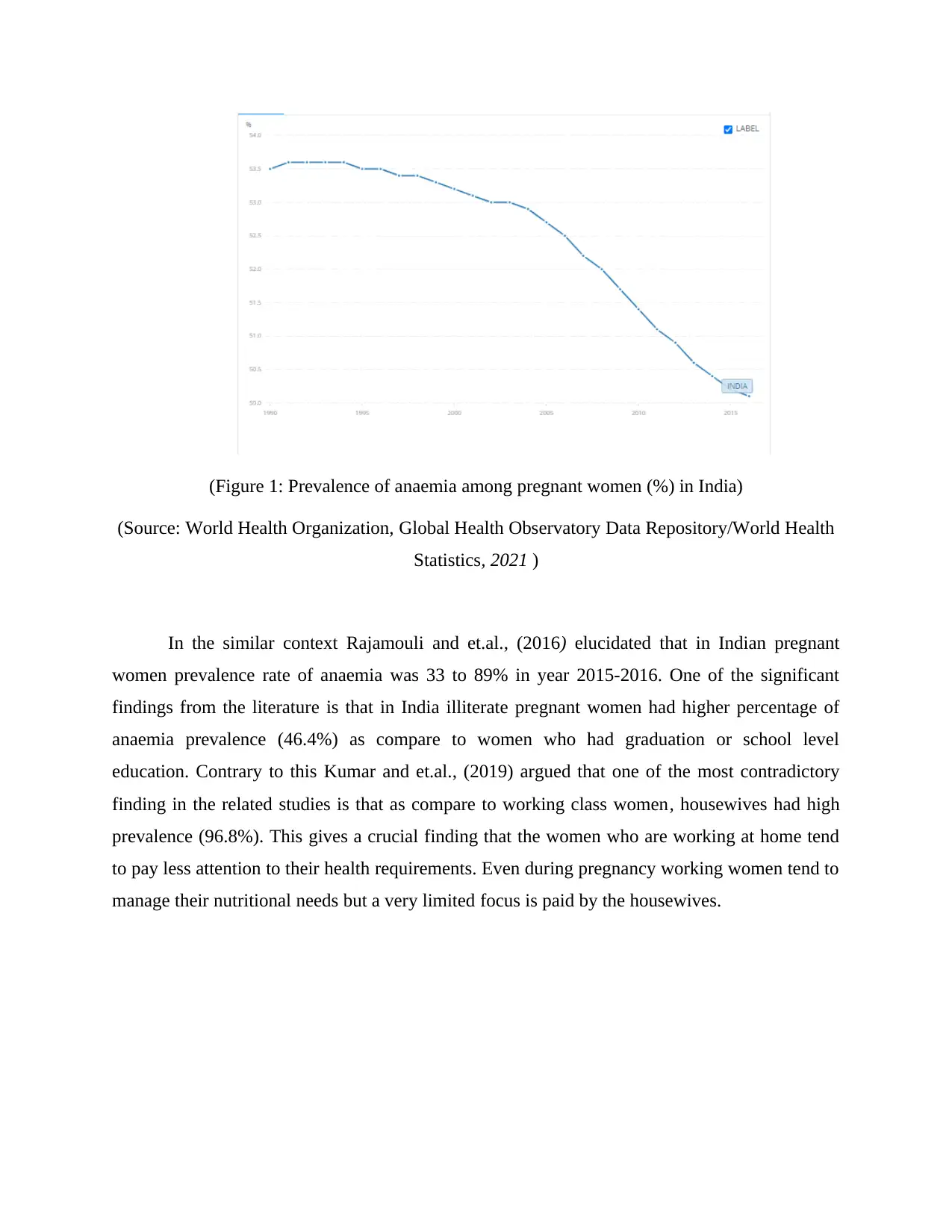
(Figure 1: Prevalence of anaemia among pregnant women (%) in India)
(Source: World Health Organization, Global Health Observatory Data Repository/World Health
Statistics, 2021 )
In the similar context Rajamouli and et.al., (2016) elucidated that in Indian pregnant
women prevalence rate of anaemia was 33 to 89% in year 2015-2016. One of the significant
findings from the literature is that in India illiterate pregnant women had higher percentage of
anaemia prevalence (46.4%) as compare to women who had graduation or school level
education. Contrary to this Kumar and et.al., (2019) argued that one of the most contradictory
finding in the related studies is that as compare to working class women, housewives had high
prevalence (96.8%). This gives a crucial finding that the women who are working at home tend
to pay less attention to their health requirements. Even during pregnancy working women tend to
manage their nutritional needs but a very limited focus is paid by the housewives.
(Source: World Health Organization, Global Health Observatory Data Repository/World Health
Statistics, 2021 )
In the similar context Rajamouli and et.al., (2016) elucidated that in Indian pregnant
women prevalence rate of anaemia was 33 to 89% in year 2015-2016. One of the significant
findings from the literature is that in India illiterate pregnant women had higher percentage of
anaemia prevalence (46.4%) as compare to women who had graduation or school level
education. Contrary to this Kumar and et.al., (2019) argued that one of the most contradictory
finding in the related studies is that as compare to working class women, housewives had high
prevalence (96.8%). This gives a crucial finding that the women who are working at home tend
to pay less attention to their health requirements. Even during pregnancy working women tend to
manage their nutritional needs but a very limited focus is paid by the housewives.
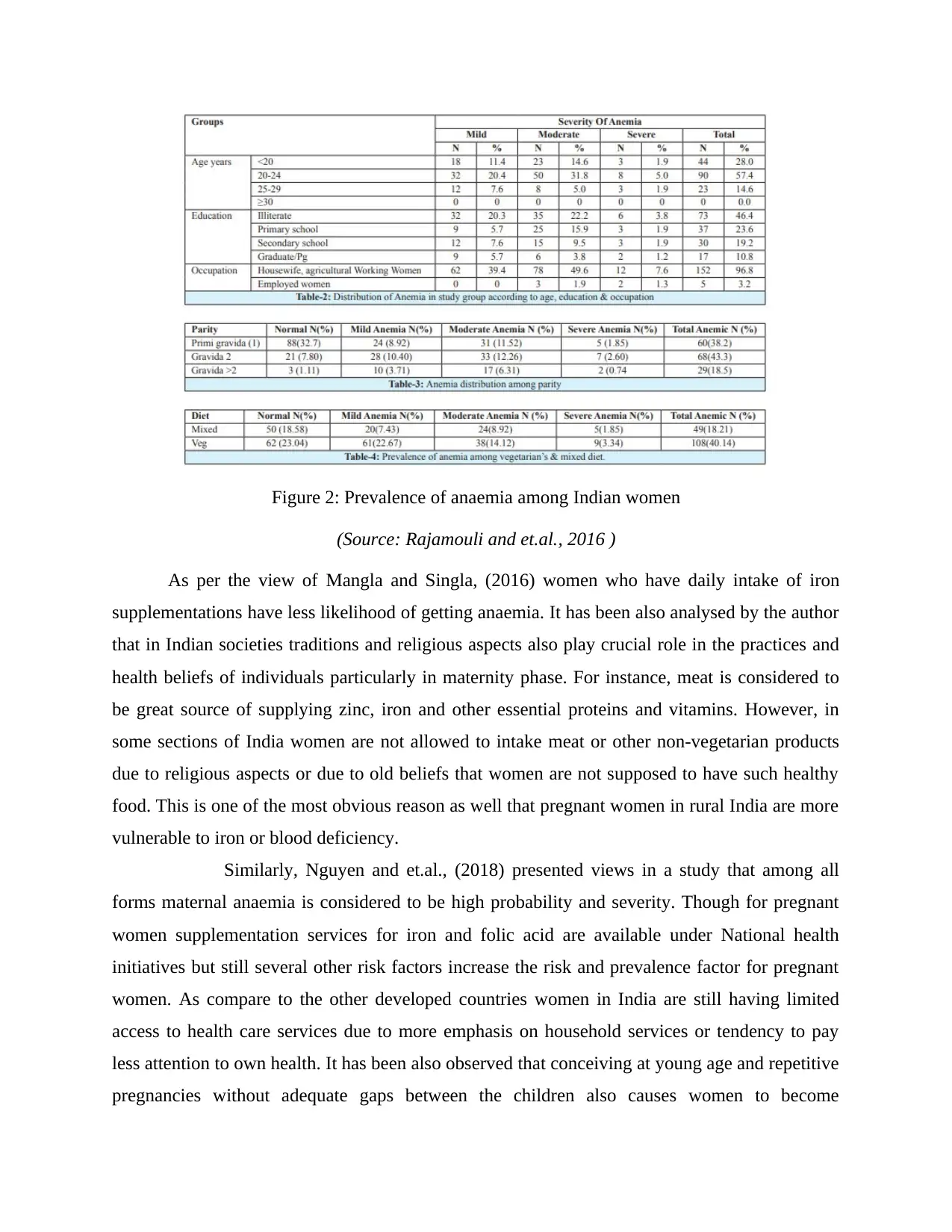
Figure 2: Prevalence of anaemia among Indian women
(Source: Rajamouli and et.al., 2016 )
As per the view of Mangla and Singla, (2016) women who have daily intake of iron
supplementations have less likelihood of getting anaemia. It has been also analysed by the author
that in Indian societies traditions and religious aspects also play crucial role in the practices and
health beliefs of individuals particularly in maternity phase. For instance, meat is considered to
be great source of supplying zinc, iron and other essential proteins and vitamins. However, in
some sections of India women are not allowed to intake meat or other non-vegetarian products
due to religious aspects or due to old beliefs that women are not supposed to have such healthy
food. This is one of the most obvious reason as well that pregnant women in rural India are more
vulnerable to iron or blood deficiency.
Similarly, Nguyen and et.al., (2018) presented views in a study that among all
forms maternal anaemia is considered to be high probability and severity. Though for pregnant
women supplementation services for iron and folic acid are available under National health
initiatives but still several other risk factors increase the risk and prevalence factor for pregnant
women. As compare to the other developed countries women in India are still having limited
access to health care services due to more emphasis on household services or tendency to pay
less attention to own health. It has been also observed that conceiving at young age and repetitive
pregnancies without adequate gaps between the children also causes women to become
(Source: Rajamouli and et.al., 2016 )
As per the view of Mangla and Singla, (2016) women who have daily intake of iron
supplementations have less likelihood of getting anaemia. It has been also analysed by the author
that in Indian societies traditions and religious aspects also play crucial role in the practices and
health beliefs of individuals particularly in maternity phase. For instance, meat is considered to
be great source of supplying zinc, iron and other essential proteins and vitamins. However, in
some sections of India women are not allowed to intake meat or other non-vegetarian products
due to religious aspects or due to old beliefs that women are not supposed to have such healthy
food. This is one of the most obvious reason as well that pregnant women in rural India are more
vulnerable to iron or blood deficiency.
Similarly, Nguyen and et.al., (2018) presented views in a study that among all
forms maternal anaemia is considered to be high probability and severity. Though for pregnant
women supplementation services for iron and folic acid are available under National health
initiatives but still several other risk factors increase the risk and prevalence factor for pregnant
women. As compare to the other developed countries women in India are still having limited
access to health care services due to more emphasis on household services or tendency to pay
less attention to own health. It has been also observed that conceiving at young age and repetitive
pregnancies without adequate gaps between the children also causes women to become
⊘ This is a preview!⊘
Do you want full access?
Subscribe today to unlock all pages.

Trusted by 1+ million students worldwide
1 out of 23
Related Documents
Your All-in-One AI-Powered Toolkit for Academic Success.
+13062052269
info@desklib.com
Available 24*7 on WhatsApp / Email
![[object Object]](/_next/static/media/star-bottom.7253800d.svg)
Unlock your academic potential
Copyright © 2020–2025 A2Z Services. All Rights Reserved. Developed and managed by ZUCOL.





